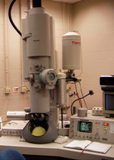FPL's Mission and Strategic Plan - 2010
FPL's mission is to identify and conduct innovative wood and fiber utilization research that contributes to conservation and productivity of the forest resource, thereby sustaining forests, the economy, and quality of life.
Integral to the mission and strategic plans and goals of the United States Department of Agriculture and directly aligned with the mission and emerging research areas of the US Forest Service Strategic Plan,
FPL Leadership and Scientists ensure that the needs of society are being met through the focusing of its research initiatives in the 5 research emphasis areas that are defined as:
FPL's Research Emphasis Areas
The mutual strategies and goals outlined in these plans ensure that the driving forces affecting our world and lives are being addressed through the research that FPL is conducting.
The USDA, US Forest Service and Forest Products Laboratory Strategic Plans
| To provide leadership on food, agriculture, natural resources, and related issues based on sound public policy, the best available science, and efficient management. | To sustain the health, diversity, and productivity of the Nation's forests and grasslands to meet the needs of present and future generations. | To identify and conduct innovative wood and fiber utilization research that contributes to conservation and productivity of the forest resource, thereby sustaining forests, the economy, and quality of life. |
The driving forces affecting our world and lives that are addressed through FPL's research initiatives
 Sequestering Carbon
- Global warming observed over the past 50 years is due primarily to human-induced emissions of heat-trapping gases. The United Nations Framework Convention recognized the scientific view that an increase in global temperatures should be less than two degrees Celsius. There will need to be a wide range of aggressive mitigation strategies to hold down atmospheric greenhouse gas levels and achieve this goal. One such strategy is the addition of carbon to forest and forest products sinks, which will be important to limiting atmospheric carbon dioxide concentrations.
Sequestering Carbon
- Global warming observed over the past 50 years is due primarily to human-induced emissions of heat-trapping gases. The United Nations Framework Convention recognized the scientific view that an increase in global temperatures should be less than two degrees Celsius. There will need to be a wide range of aggressive mitigation strategies to hold down atmospheric greenhouse gas levels and achieve this goal. One such strategy is the addition of carbon to forest and forest products sinks, which will be important to limiting atmospheric carbon dioxide concentrations.
Forest products research can contribute to the mitigation of greenhouse gas emissions in many ways, including 1) improving durability of wood products to increase storage of carbon in long-lived forest products, 2) increasing performance of wood products so they may substitute steel and concrete which produce more greenhouse gases in their manufacture and use, 3) providing cost-effective processes for producing liquid biofuels which emit less greenhouse gases than gasoline or diesel fuels, 4) decreasing energy use and greenhouse gas emissions from the production of solid wood and paper products, and 5) providing economic uses for small diameter timber and thereby encouraging fire hazard reduction treatments that reduce greenhouse gas emissions from wildfires.
 Sustainable Forestry
- Sustainable development of forests is a key international and domestic objective. Population growth and development pressures are resulting in deforestation in many developing countries, and maintaining benefits from forests worldwide is critical to ensure they are not replaced by other uses, such as agriculture or urban development. In order to keep forests as forests, it is critical to provide efficient, high-value uses for the wood that is removed. Forest products research is vital to achieving those goals, thereby ensuring retention of forest lands and the many benefits they provide.
Sustainable Forestry
- Sustainable development of forests is a key international and domestic objective. Population growth and development pressures are resulting in deforestation in many developing countries, and maintaining benefits from forests worldwide is critical to ensure they are not replaced by other uses, such as agriculture or urban development. In order to keep forests as forests, it is critical to provide efficient, high-value uses for the wood that is removed. Forest products research is vital to achieving those goals, thereby ensuring retention of forest lands and the many benefits they provide.
 Alternative Energy Sources
- Given the need to reduce emissions of greenhouse gases, decreases in the availability and security of conventional domestic and international energy supplies, and increases in energy demands in the United States and around the world, there is a need to develop and enhance alternative energy sources and more energy-efficient technologies. Research and development can help create new alternative renewable energy sources with wide-ranging beneficial impacts. These alternatives will not only increase the energy efficiency of forest operations, wood conversion, and manufacturing processes, they can also lead to more energy-efficient housing, cost-effective ligno-cellulosic biofuel conversion processes, and biorefinery options for producing chemicals and energy.
Alternative Energy Sources
- Given the need to reduce emissions of greenhouse gases, decreases in the availability and security of conventional domestic and international energy supplies, and increases in energy demands in the United States and around the world, there is a need to develop and enhance alternative energy sources and more energy-efficient technologies. Research and development can help create new alternative renewable energy sources with wide-ranging beneficial impacts. These alternatives will not only increase the energy efficiency of forest operations, wood conversion, and manufacturing processes, they can also lead to more energy-efficient housing, cost-effective ligno-cellulosic biofuel conversion processes, and biorefinery options for producing chemicals and energy.
 Urbanization
- Although urban and suburban residents today are more removed from working forests and rangelands for their livelihoods, their quality of life and well-being continue to depend upon forests and rangelands-sometimes far distant from their homes. Today social, cultural, economic, and political views of urban populations directly and indirectly influence the use and value of all U.S. forests and rangelands. Society needs timely and accurate information and tools to manage, create, and sustain forests and their critical goods and services in increasingly urbanized and urban-influenced areas.
Urbanization
- Although urban and suburban residents today are more removed from working forests and rangelands for their livelihoods, their quality of life and well-being continue to depend upon forests and rangelands-sometimes far distant from their homes. Today social, cultural, economic, and political views of urban populations directly and indirectly influence the use and value of all U.S. forests and rangelands. Society needs timely and accurate information and tools to manage, create, and sustain forests and their critical goods and services in increasingly urbanized and urban-influenced areas.
 Globalization
- Nations, people, businesses, and natural resources are becoming increasingly interconnected globally, with rapid movement of people, capital, technology, and goods across national borders. Globalization expands competition and accelerates structural changes in natural resource product markets and resource uses and values. Decisions and actions in the United States and abroad may have significant environmental, social, and economic ramifications at multiple scales, from local to global. These interactions are leading to changes in forest and rangeland conditions and land uses, and ultimately, to changes in associated ecosystem services such as water quality and production, carbon sequestration, energy options, wildlife habitat, and recreation opportunities. The impacts of these changes are eventually felt in terms of employment opportunities and quality of life for citizens.
Globalization
- Nations, people, businesses, and natural resources are becoming increasingly interconnected globally, with rapid movement of people, capital, technology, and goods across national borders. Globalization expands competition and accelerates structural changes in natural resource product markets and resource uses and values. Decisions and actions in the United States and abroad may have significant environmental, social, and economic ramifications at multiple scales, from local to global. These interactions are leading to changes in forest and rangeland conditions and land uses, and ultimately, to changes in associated ecosystem services such as water quality and production, carbon sequestration, energy options, wildlife habitat, and recreation opportunities. The impacts of these changes are eventually felt in terms of employment opportunities and quality of life for citizens.
 Rapid Changes in Technology
- Rapid changes in technology and the ways that information is located and shared via the Internet have contributed to the transformation of businesses and society. Dispersion of people, their homes, and workplaces across once-rural landscapes is changing patterns of land use, and having significant impacts on ecological and human social systems. In addition, continuing advances in information accessibility on the Internet are changing the traditional ways that research findings are disseminated and increasing the ability of citizens to access complex scientific information and engage in public discourse about environmental issues and the future management of natural resources.
Rapid Changes in Technology
- Rapid changes in technology and the ways that information is located and shared via the Internet have contributed to the transformation of businesses and society. Dispersion of people, their homes, and workplaces across once-rural landscapes is changing patterns of land use, and having significant impacts on ecological and human social systems. In addition, continuing advances in information accessibility on the Internet are changing the traditional ways that research findings are disseminated and increasing the ability of citizens to access complex scientific information and engage in public discourse about environmental issues and the future management of natural resources.
 Economic Forces
- The status of the economy, both in the United States and around the world, plays a key role in determining whether technologies emerging from research and development program are successfully implemented. New products and technologies must be not only technically feasible and beneficial to society, but also economically viable in the global market place.
Economic Forces
- The status of the economy, both in the United States and around the world, plays a key role in determining whether technologies emerging from research and development program are successfully implemented. New products and technologies must be not only technically feasible and beneficial to society, but also economically viable in the global market place.
 Political and Social Forces
- Congress, Administration priorities, and the needs and expectations of the American public will continue to strongly influence the Forest Products Laboratory. Public expectations for comfort, convenience, safety, and health remain strong, and concerns about the environmental and public health impacts of industrial processes, sustainability of natural resources, consumption, product disposal, and renewable energy are on the rise.
Political and Social Forces
- Congress, Administration priorities, and the needs and expectations of the American public will continue to strongly influence the Forest Products Laboratory. Public expectations for comfort, convenience, safety, and health remain strong, and concerns about the environmental and public health impacts of industrial processes, sustainability of natural resources, consumption, product disposal, and renewable energy are on the rise.











